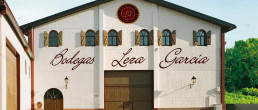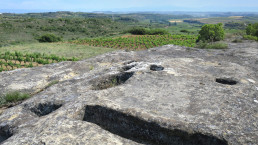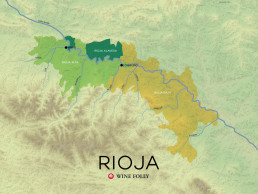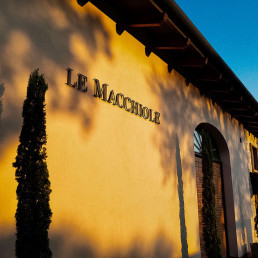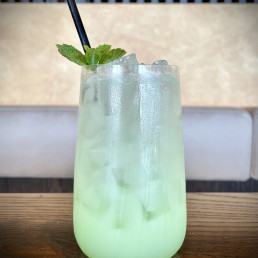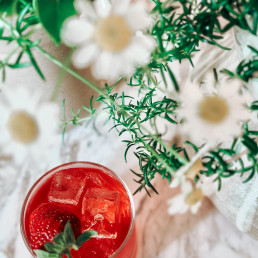Introducing… the Valdepalacios Rioja Red Tempranillo from Bodegas y Viñedos Leza García to the Dhall & Nash stable – your new go-to to impress everyone around the table!
“Why isn’t Rioja considered a fine wine? It’s one of the world’s most rewarding wine regions, capable of profound, ageworthy bottlings. Yet too many people dismiss it as a good-value glugger”
― Tim Atkin MW
Rioja (Ree-oh-ha) is perhaps one of Spain’s most well-known wine regions, and the chances are if you’re reading this, then you’re at least somewhat familiar with this vinous MVP!
Rioja is widely regarded as a crowd-pleasing table-wine that represents good value and approachability (rightfully) but there’s a lot more to know about this ancient D.O.Ca…
“Many a good story has been found in the bottom of a decent Rioja.”
― Ken Scott
It’s not uncommon to hear someone talking about a “Rioja” wine like they’d talk about a “Bordeaux” or “Chablis” – referring to the region so synonymous with their own styles the nouns have become virtually interchangeable. While Bordeaux is all about the Cabernet/Merlot blends and Chablis smashes the Chardy’ game – Tempranillo is the star in the valleys of La Rioja.
Dhall & Nash is immensely excited to be bringing on Valdepalacios Tempranillo from Bodegas y Viñedos Leza García, a family-owned endeavour for three generations. But first, let’s look at the foundations of Rioja and the dedicated Leza García family’s special piece of earth within it.
Tempranillo – The Rioja Star
Tempranillo (temp-rah-nee-oh) is the star grape of Rioja wines. While it’s often blended with small percentages of other varieties, this medium-bodied black grape variety is almost always the star, which isn’t surprising given it’s Spain’s most widely planted varietal. Interestingly enough though, while it’s far from rare around these parts, it’s scarcely found anywhere else other than the Iberian Peninsula – 87% of Tempranillo vines are found in Spain alone!
Boasting typical flavours of cherry, red berries and fig with savoury, earthen undertones, think cedar, tobacco or even dried herb. Wines usually have medium-high tannin levels (the compound that makes your lips pucker and your cheeks feel dry) but they’re usually balanced by medium-high acidity levels, resulting in a satisfying balance that makes it a stellar food wine when it comes to rich dishes. This also makes Tempranillo an ideal addition for the Portuguese making Portos, where the grape is known as ‘Tinto Fino’ or ‘Tinta Roriz’.
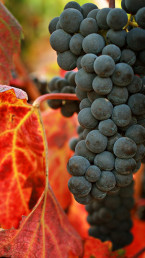
Styles
In Rioja, there are four ‘tiers’ of Rioja DOCa wines: Generic, Crianza, Reserva and Gran Reserva, which are determined by length of ageing and the vessel. There are certain parameters within each of these tiers for reds, whites, rosés and sparklings, but for the purpose of this blog not being thesis-length, we’ll focus on reds.
- Generic: No specific ageing requirements – it’s a very broad category. Most wines in this tier will be affordable and approachable.
- Crianza: Must be aged for >2 years, with at least 12 months in barrel.
- Reserva: Must be aged for >3 years, with at least 12 months in barrel and 6 months in bottle.
- Gran Reserva: The highest tier, which affords a higher price tag than its younger counterparts (yet still often remarkably affordable for such quality, pre-matured wine) must be aged for at least 5 years, 24 months of which must be in barrel and 24 months must be in bottle.
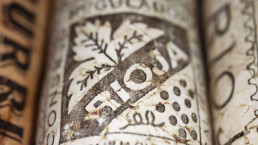
La Rioja History
It’s no surprise for an old-world wine country, but viticulture in Rioja has ancient origins…
The First Grapes: The phoenicians – a pretty pioneering culture in the world of wine, to put it lightly – had settlements in La Rioja as early as the 11th Century BC.
Romans Move In: In the 2nd Century BC, the ancient Romans (note: big wine fans) came into the area and that’s when viticulture really took off. Lots of Roman soldiers with big appetites for wine meant Bodegas started to pop up left, right and centre to satisfy the thirsty troops.
In 1989, Roger Dion, a notable wine historian, proposed that when the Romans then settled in Bordeaux, some of the plant cuttings could have been the ancient vine ‘Balisca’ from Rioja, thought to be the ancestor to (the very vogue) Cabernet Sauvignon, Cabernet franc, Merlot and Petit Verdot in the Médoc wine region.
Remains of a medieval wine press (By Adam Cli)
Reputation Whispers: Throughout the middle ages, people would go on pilgrimages to visit the shrine of St. James at Santiago de Compostela, and it was via these travellers who passed through the Rioja region that word initially began to spread about the tasty ‘local’ wines the pilgrims were discovering as they passed through… a statue of St. James the Apostle in Logroño that greeted the pilgrims travelling through Rioja on their way to Santiago de Compostela

fr.Wikipedia (By Jynus)
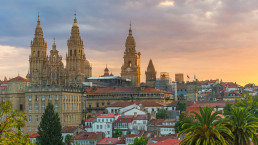
Santiago de Compostela
Spreading the Party: Through all of this, Rioja wine stayed close to home. It was a treat enjoyed by locals and travellers but exports didn’t start until after the ‘Reconquista’ (the holy military campaigns waged on the Iberian Peninsula) in the 1490’s. Merchants began to take their wines to the trading ports for the British and Dutch to enjoy.
Eureka! Oak!: In the late 1700’s, one Don Manuel Quintano travelled to Bordeaux, already well-known for their tasty drops (shoutout to the Balisca vines… maybe) to learn their winemaking technique, and brought back with him the knowledge of oak-ageing, which vastly improved the ability and export potential and BOOM! From there, the wines of La Rioja started to become known far and wide!
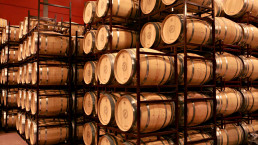
Phylloxera (dun-dun-dun): Whilst the infamous phylloxera plague of the late 19th century decimated most vineyards in Europe with France being particularly hard-hit, Rioja found itself rather fortunate. The louse that was wreaking havoc through the vineyards hadn’t (yet) reached Spain. At first, this presented itself as a huge and sudden increase in demand as the French cast their eyes yonder to get their vinous fix. Then later, it transpired that flocks of French winemakers decided to up and move to other promising regions around the world – La Rioja being one of them. With these practised winemakers came immense knowledge and finesse that catapulted the quality (and popularity!) of the Rioja wines. By the time Phylloxera started affecting the vineyards of Spain, it had been worked out that grafting resistant American rootstock to their vines was an effective fix, so there was significantly less panic.
War Times: Throughout the early half of the 20th Century, the reputation for Rioja’s wines was firmly embedded, but it was a period of turmoil world-wide, as we all know. With two world wars as well as a civil one, Spain had to prioritise and make some tough decisions. A lot of vineyards were uprooted to free up land for crops and food for the hungry population.
In Living History: Throughout the 1960’s there was a concentrated effort to replant and reinvigorate the viticulture in the region – thankfully with great success. Both the 1964 and 1970 vintages were particularly exceptional, with wines from the vintages still holding up today in tastings. Some critics dub them the ‘Vintages of the Century’.
La Rioja Terroir
The La Rioja region is about 3 three-hour road-trip from Madrid, and is made up of seven valleys in three zones in the north of Spain. The region centres around the Ebro River and its 7 small tributaries, which split up the Valleys. Overall, it’s around 100 km long and 40 km wide with over 65,000 hectares under vine. (Just over twice the size of Burgundy or half the size of Bordeaux.) The area is delimited by the Sierra de Cantabria to the north and the Sierra de la Demanda to the south, protecting itand differentiating it from its surroundings. The confluence of the Atlantic and Mediterranean climates, with moderate average temperatures around 15º and annual rainfall between 400 and 600 l/m2, is ideal for vine growing.
Img Credit: WineFolly, who do a fantastic in-depth breakdown of each terroir here.
From the top down:
- Oja Valley: The highest elevations with clay and sandy alluvial soils.
- Najerilla Valley: The most heavily planted valley with iron-clay orangey soils.
- Iregua Valley: Varied crops including walnuts, olives etc. Iron-clay and alluvial sandy clay.
- Leza Valley: Dramatic and rocky with iron-rich clay.
- Jubera Valley: Higher limestone content than other areas.
- Cidacos Valley: A hotter and drier valley, with iron-clay and limestone-clay.
- Alhama Valley: A secret southern gem, the vineyards are found in the mountainous areas (where you’ll actually find a UNESCO biosphere reserve recognized for its diversity of flora and fauna.)
Each of these valleys fall within the three main regions of Rioja:
- Rioja Alta: the north-western end encompassing the Oja, Najerilla and Iregua Valleys. 28,000 hectares. (This is where Bodegas Leza García are!)
- Rioja Alavesa: Toward the centre and north of the region, it doesn’t cover any of the Valleys but is planted with just over 13,000 hectares. Mostly smaller, family-run wineries.
- Rioja Oriental: AKA ‘Rioja Baja’ until very recently (officially in 2018). Encompasses a small section of the Iregua Valley as well as the Leza, Jubera, Cidacos and Alhama Valleys.
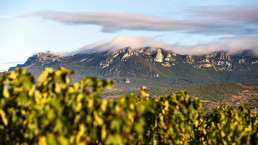
Rioja’s Reputation and Place in the Market
Rioja is well-known, well-respected, well-liked and yet it’s a contradiction unto itself in that the recognition of its quality seems to cease once you start jumping up the price tiers, but the reason for this is murky. You’d be far more likely to see someone drop $100 on a nice Bordeaux than a Rioja, but why? How did Rioja become ‘always the bridesmaid, never the bride’?
Tim Atkin MW has some thoughts; “Very cheap wines from most of the world’s major wine regions are invariably undrinkable. You’d be taking your life in your hands opening a bottle of Barolo, Bordeaux or red Burgundy at that price. But Rioja is rarely terrible, even when it’s sloshing around in the depths of wine’s bargain basement. This is a plus point in some ways – what’s wrong with a bit of reliability in topsy-turvy times? – but it also means that, in many people’s eyes, Rioja lacks gravitas.“ he explains, “It’s one of the world’s most rewarding wine regions, capable of profound, ageworthy bottlings. Yet too many people dismiss it as a good-value glugger.”
“It can be good value, award-winning, and there are some great Rioja vintages,” the team at Right Casa explain, “Rioja can be a world-class wine. But it is widely considered by those in the know to be a ‘bargain wine’…There are many factors that place Rioja firmly in the ‘good value for money’ category. Firstly the value of the wine itself is a reason that rioja can’t be elevated to a fine wine. It is a middle of the road and cost effective wine, which is good news for price-conscious consumers but prevents the wine from being considered prestigious by wine critics and enthusiasts.”
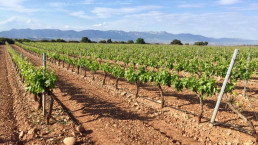
Other critics are more forward with their compliments, “I have to start by saying that Rioja is possibly the most dynamic region in Spain at the moment,“ remarks Luis Gutiérrez for Robert Parker’s The Wine Advocate, “They have capabilities and potential to produce world-class wines.” (There’s always a ‘but’ where Rioja is concerned, and in Luis’ case, he is worried about the effects of climate and hands in the vineyards, but that’s a tangent for another time…)
All that said, however, whilst stashing a few Riojas in the cellar could possibly reward you, it’s still seen as the ‘mum-friend’ of the wine-world… but that’s not necessarily a bad thing. There’s a place for aged, complex and fine wines (as a fine wine company full of vinous-fanatics, trust us…) but there’s something to be said about approachability. Taking a bottle of Opus One or Chateau Margaux to the dinner party would definitely earn you some expensive brownie-points, but for the average punter, there comes a point where you just want something *everyone* will enjoy, not just the discerning palates around the table. This is where Rioja absolutely shines. It bridges that gap between lovers of finer wines and those who genuinely do just want a good red with their steak. It’s easy and delicious.
Speaking to Matt Kramer of Wine Spectator (In his aptly titled article: ‘Is Rioja Today’s Most Overlooked (and Underappreciated) Wine?’), 5th-gen owner of CVNE winery Victor Urrutia laments, “What I’d like to know now is what will it take for people outside of Spain to recognize the greatness of Rioja’s wines?…I don’t believe that any wine region anywhere in the world offers greater value—by which I mean higher quality at a fairer price—than Rioja. And I’m not just talking about my wines, mind you. We age our wines longer than almost anybody. And really, we don’t charge for that. Or not much anyway. When you buy a good red Rioja, even though it can age in your cellar for decades more, it’s far more ready to drink, far more along in its evolution, than almost any fine red wine from anywhere else.”
Matt Kramer agreed with Victor, offering the opinion that Rioja offers both immensely high-quality matured wines as well as “oceans” of young, simple wines. He stresses though, that the wines being ‘young and simple’ is not the brush-off it may seem. “Even at the low price end, you need only visit… to witness the commitment to Rioja’s traditional taste preference for a rounder maturity, however modest the wine.”
BBC Good Food has dubbed Rioja the Ultimate Comfort Wine – “Rioja that is based on tempranillo typically has a soft, smooth, warm taste, with notes of baked strawberries and hay.”
So let’s break this down in simple terms – a Pros and Cons list!
Rioja Pros
- #1… it’s delicious
- Widely appealing
- Affordable
- Ageing-potential
Rioja Cons
- Not considered “fine”
- …??
Leza García
Bodegas y Viñedos Leza García is the third generation of a family saga that dates back to 1920, when Juan Leza Arenzana began his career in the world of wine with a small vineyard in his hometown, Uruñuela.
Juan’s natural know-how was picked up by his son, Ángel Leza, and so his legacy has been passed down to this day. Currently the winery is managed by the third generation and a fourth generation is in the process of incorporation.
“We try to offer something different, modern but friendly wines.”
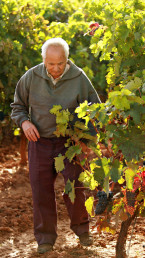
Lez García is largely based in Rioja Alta to the west. They are under the influence of an Atlantic climate and enjoy a wide variety of soils ranging from clay-limestone,clay-ferrous and alluvial. Their vineyards are located mainly in the Najerilla Valley and the Sonsierra, making it a unique enclave for the production of excellent wines.
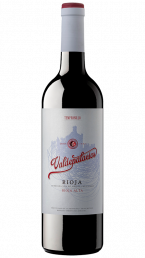
Bodegas y Viñedos Leza García
Valdepalacios Rioja Red Tempranillo 2022
Majoritively Tempranillo, Remainder Garnacha Tinta and Mazuelo.
13.5% Alc | 5.1g/L (RA) | 1.5g/L (RS)
The Tempranillo base of this classic Rioja lends typical savoury characteristics while the Garnacha Tinta and Mazuelo give it a fruity burst of life! It’s clean and bright and harmonious with the acidity, freshness and softness all in perfect balance with one another. Think crunchy red cherry and cranberries with an earthy vanilla edge.
Serve between 12°C – 14°C with Mediterranean dishes, rice, vegetables, pasta and all kinds of meats.

